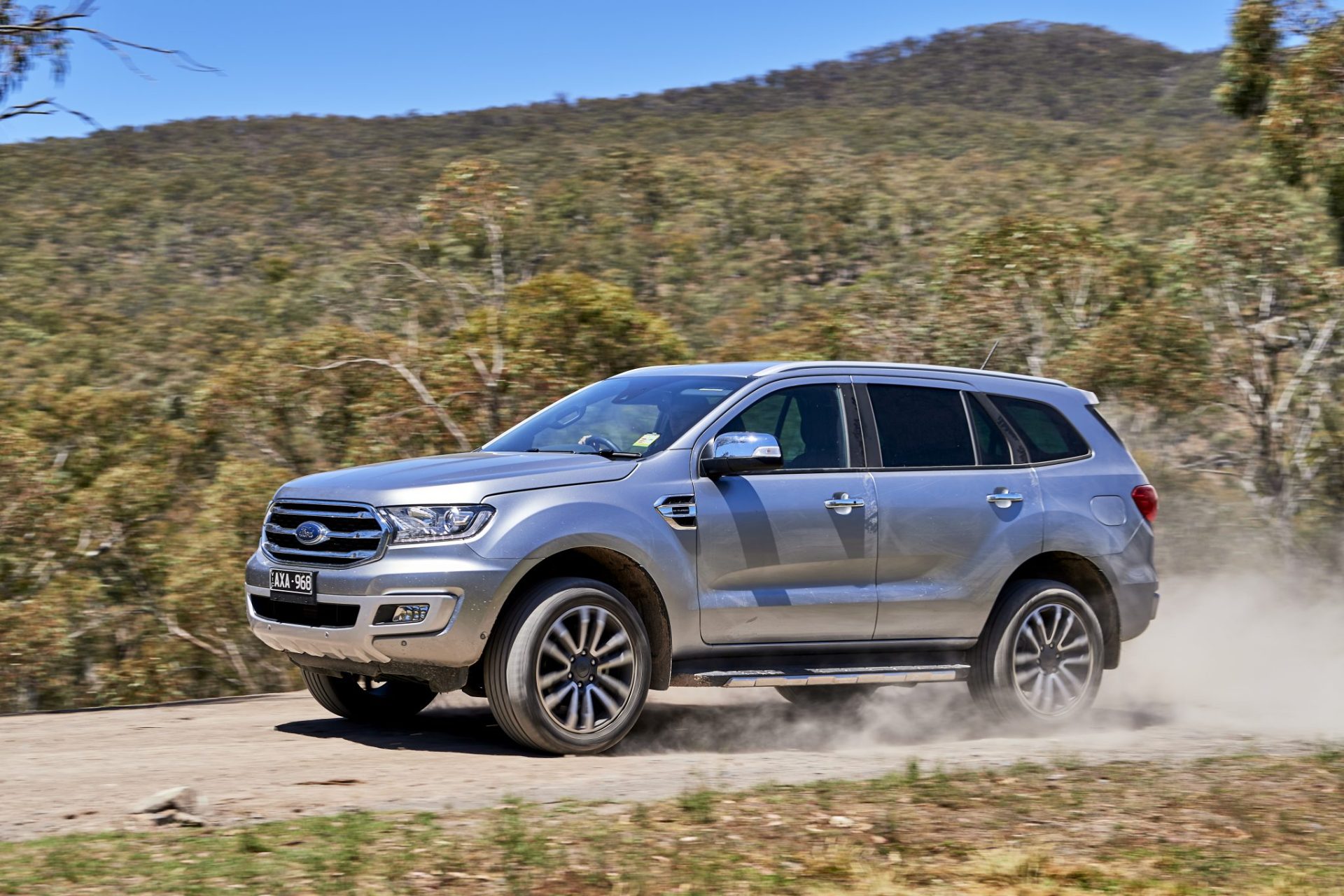Both share plenty of oily bits with their ute siblings and offer seven seats and genuine off-road ability, so which one should you go for?
Ford Everest Titanium Specifications
Price from $73,990+ORC Warranty five-years, unlimited kilometres Service Intervals 12 months, 15,000km Safety five-star ANCAP (2015) Engine 2.0-litre bi-turbo four-cylinder diesel Power 157kW at 3750rpm Torque 500Nm from 1750-2000rpm Transmission 10-speed automatic Drive all-wheel drive with low-range Dimensions 4649mm long, 2180mm wide (with mirrors), 1837mm high, 2850mm wheelbase Ground Clearance 225mm measured Angles 29.5-degrees approach, 25-degrees departure, 21.5-degrees rampover Wading 800mm Weight 2446kg (fuel, no driver) GVM 3100kg GCM 5900kg Towing 3100kg Boot Size 450-2010L (loaded to the roof) Spare full-size underslung Fuel Tank 80L Thirst 7.1L/100km claimed (7.9L/100km tested)
Mitsubishi Pajero Sport Exceed
Pricing $56,990 driveaway Warranty five-years, 100,000km Service Intervals 12 months/15,000km Safety Five star ANCAP (2015) Engine 2.4-litre four-cylinder turbo-diesel Power 133kW at 3500rpm Torque 430Nm at 2500rpm Transmission eight-speed automatic Drive selectable full-time four-wheel drive Kerb weight 2105kg GVM 2710kg Payload 605kg GCM 5400kg Towing 750/3100kg Dimensions 4785mm (L); 1815mm (W); 1805mm (H) Track 1520/1515mm Ground Clearance 225mm (measured) Angles 30-degrees Approach, 23.1-degrees Rampover 24.2-degrees Departure Wading 700mm Spare Full size Fuel Tank 68L Thirst 8.0L/100km (combined)
Why compare the Pajero Sport with the Everest, they’re miles apart on price
Simple really. Price isn’t everything. Both are seven-seat off-road capable wagons that owe their origins to utes. In the case of the Pajero Sport, it’s the Mitsubishi Triton, and for the Everest, it’s the Ford Ranger.
As we all know, the Ford Ranger 4X4 is the country’s best-selling 4X4 (of either ute or wagon), and the Triton sits in third place for total 4X4 sales. And it’s a similar story where 4X4 wagons are concerned. In February, the Toyota Prado stole the show with 1230 sales while the Everest finished up with 490 and the Pajero Sport found 330 buyers. Okay, more than 100 sales between them, still these are two of the most popular seven-seat 4X4s on-sale in the country.
Some might argue there’s a fair price difference between these two. Yep, there is and a big one, but don’t let that fool you, both the Exceed and the Titanium are targeting the same buyer. If you wanted a comparison based on price, then you’d be better off running the Pajero Sport Exceed against the Ford Everest Trend, and the Pajero Sport would still leave you with change in your pocket.
So, what do they cost? The updated-for-2020 Pajero Sport Exceed we’re looking at lists from $57,190+ORCs while the Everest Titanium lists at $72,790+ORCs. Right off the bat, you could make a rock-solid case the Pajero Sport is the better bang for your buck. But we’re not judging things on price alone here.
Both of these 4X4s are top-spec models and loaded with kit
Let’s start with the Pajero Sport which was updated earlier this year. There are some minor cosmetic tweaks on the outside, while on the inside minor tweaks include soft-touch bits and pieces around the cabin, and a tunnel style centre console. There’s an AC outlet (150W) in the tunnel on the centre console and an 8.0-inch infotainment screen on the dashboard that supports both Apple and Android connectivity as well as native sat-nav for the first time. An app is available too, allowing owners to control (via Bluetooth) various vehicle functions, like opening the powered tailgate and more. But that’s about it for the new stuff.
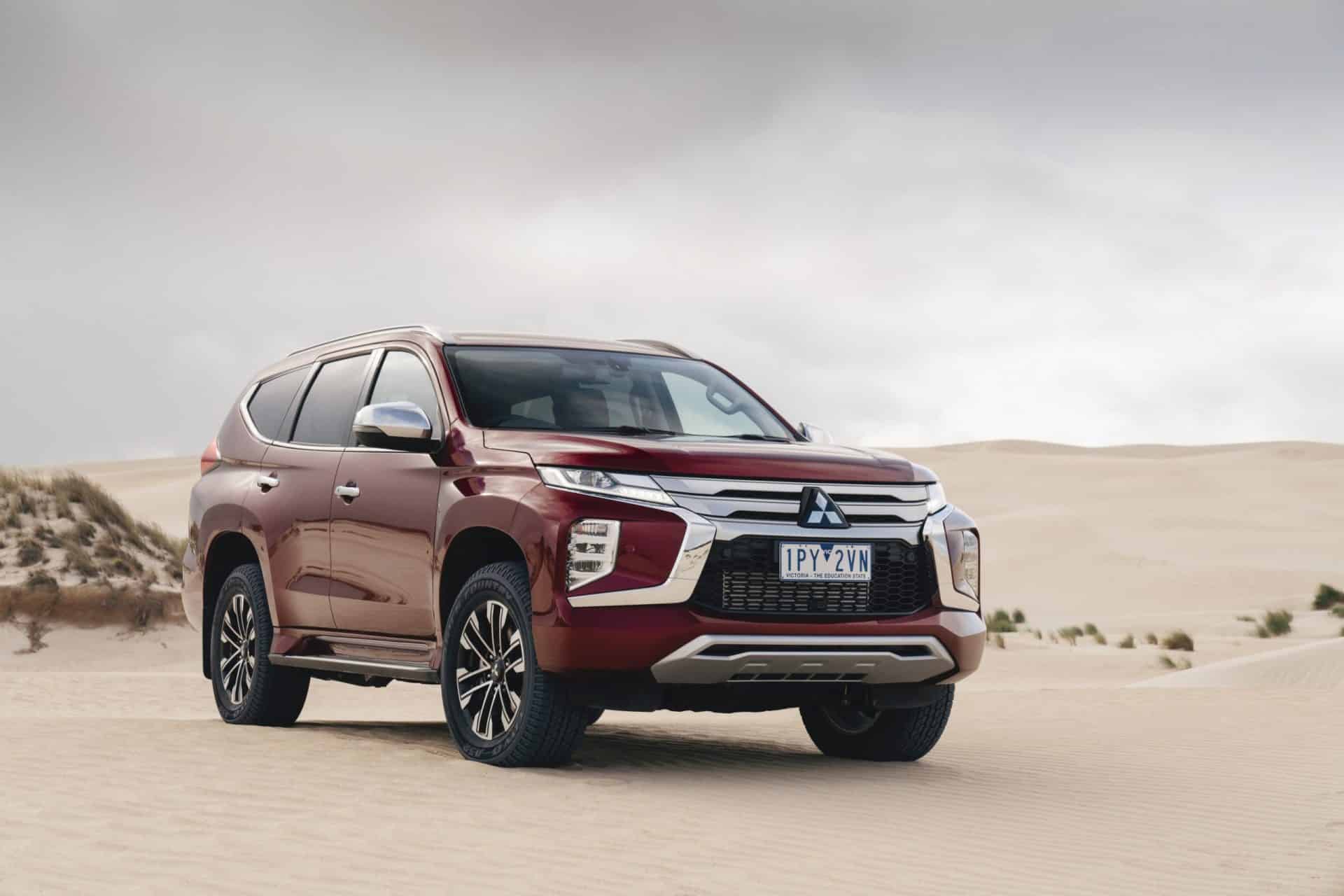
Standard features on the Pajero Sport include leather seats, dual-zone climate control with fan speed controls for those in the back, heated seats for the driver and passenger, 360-degree surround-view camera, recline function for second-row seats, 18-inch alloys with full-size spare, as well as a raft of active safety features including autonomous emergency braking, lane change assist, blind-spot monitoring and rear cross-traffic alert. It also features Mitsubishi’s Super Select 4WD-II system which offers terrain-based adjustments. All in all, for the coin, the Pajero Sport Exceed represents excellent value for money.
By comparison, the Everest Titanium is pricey, but for the money, you get a lot more gear than you do on the Pajero Sport Exceed. Standard inclusions are 20-inch alloy wheels (18s are available) a tow bar, semi-auto parallel park assist, dual glass panel powered sunroof with power blind, powered and heated front seats, power fold third-row seats, ambient lighting and illuminated stainless-steel front scuff plates.
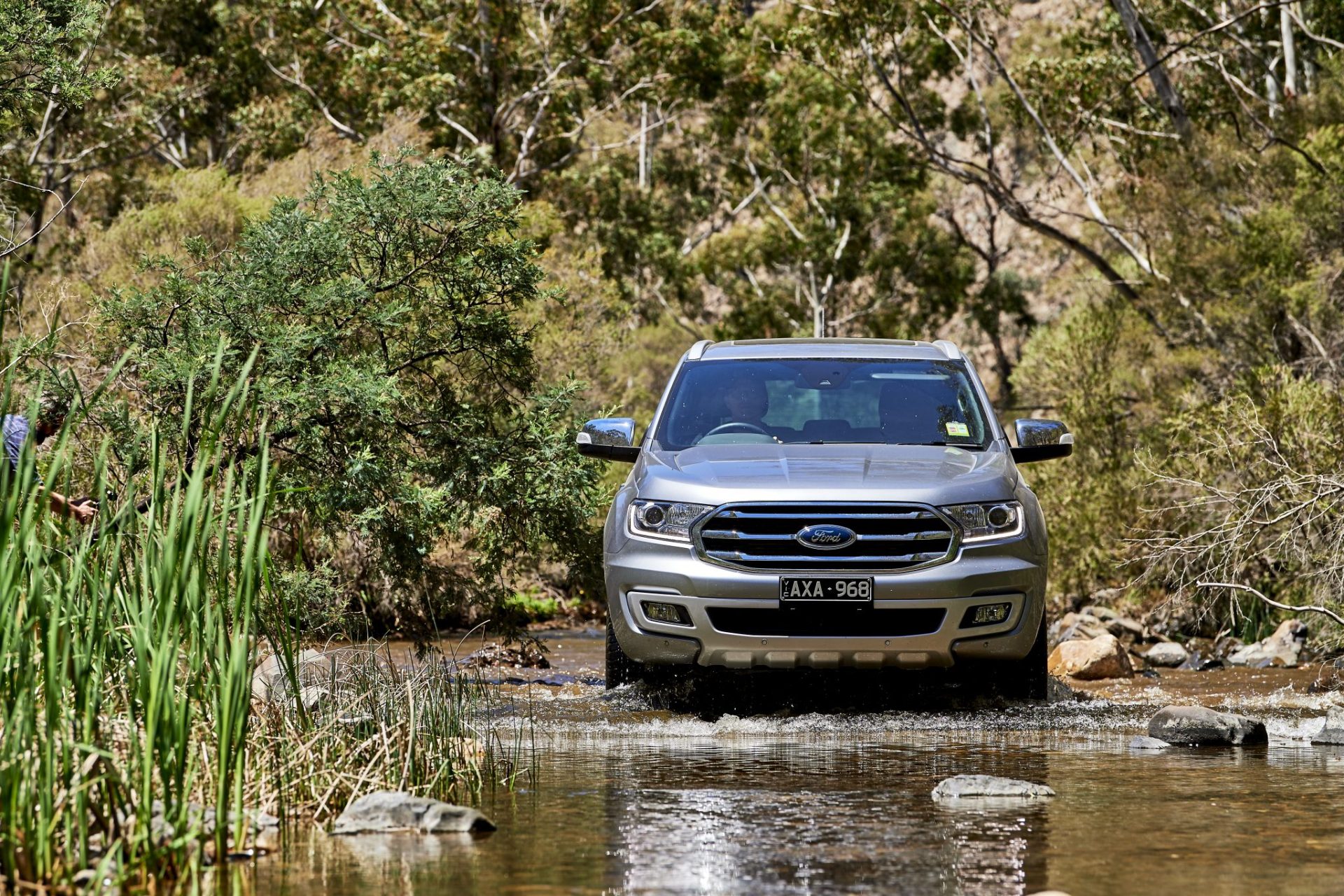
The only model in the range to offer buyers the choice of either the 3.2-litre five-cylinder diesel or the 2.0-litre bi-turbo four-cylinder diesel is the Trend; the Titanium is only available with the 2.0L engine. To be honest, if you’re looking for an off-road-oriented tourer, then you’re best off looking at the Trend.
Which one’s got the best interior?
When you’re spending the sort of coin that both these vehicles are asking, then you expect the interiors to be pretty good. And they are. They both get leather and dual-zone climate control and much more but it’s on the inside of the thing where its physical size leaves the Pajero Sport a distant second.
Let me explain. The Pajero Sport measures 1815mm wide whereas the Everest measures more than two metres, and it’s that extra 20 centimetres that makes a huge difference.
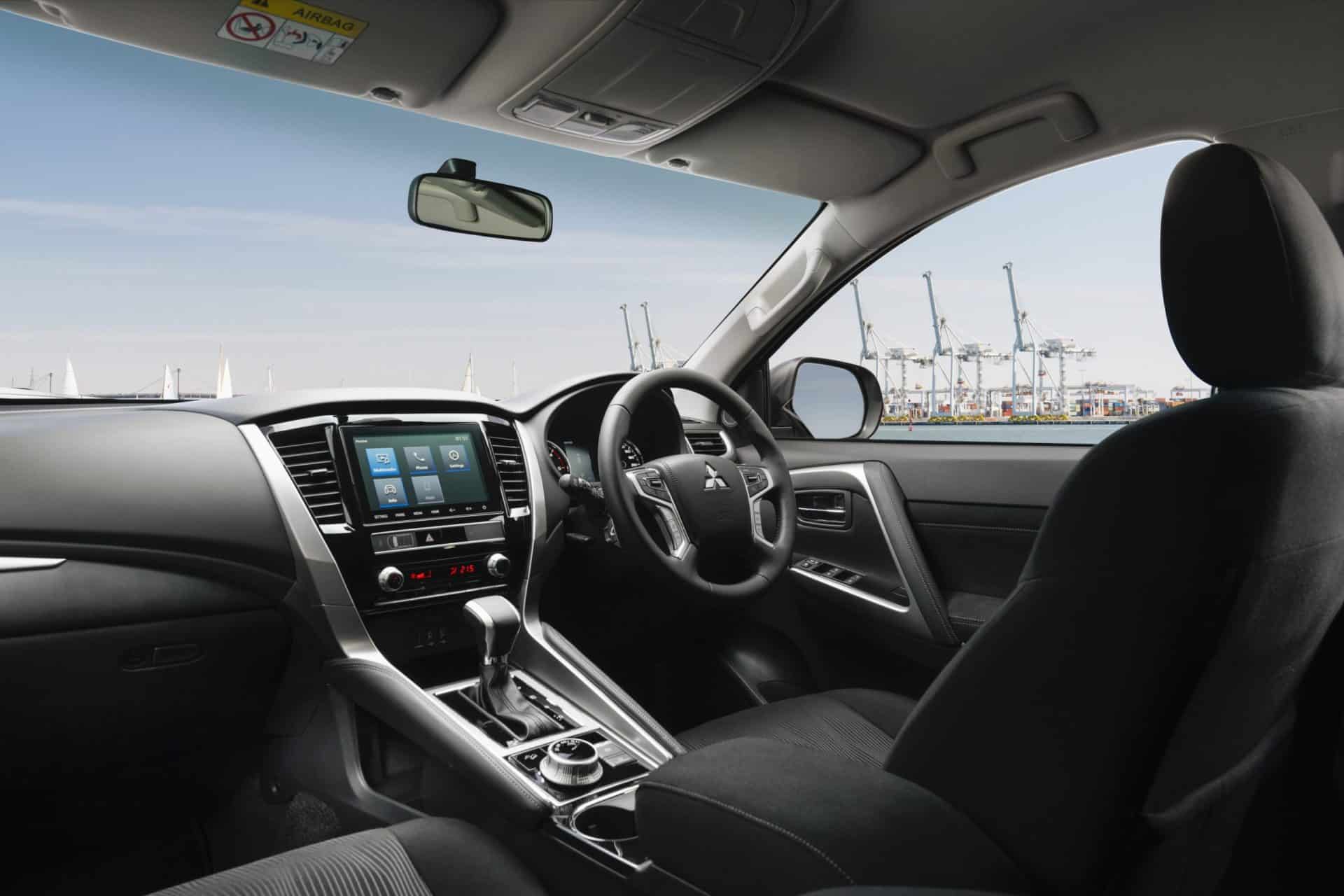
Load up the Pajero Sport, and it feels like the driver and passenger are just about sitting on top of one another and then throw a couple of people into the back, and legroom for the front passenger is reduced. Those behind the driver have to deal with less legroom. And there’s no way you can fit three adults across the back seat of the Pajero Sport.
And the seats, in general, just feel small. Me, I’m around six-feet tall and the driver’s seat while offering good support in the backrest is just too short in the seat base with no real under-thigh support – meaning you’ll become fidgety on longer drives. More than that, the centre console eats into your legroom, adding to the sense of the whole cabin feeling cramped; the pinched in roofline doesn’t help here either.
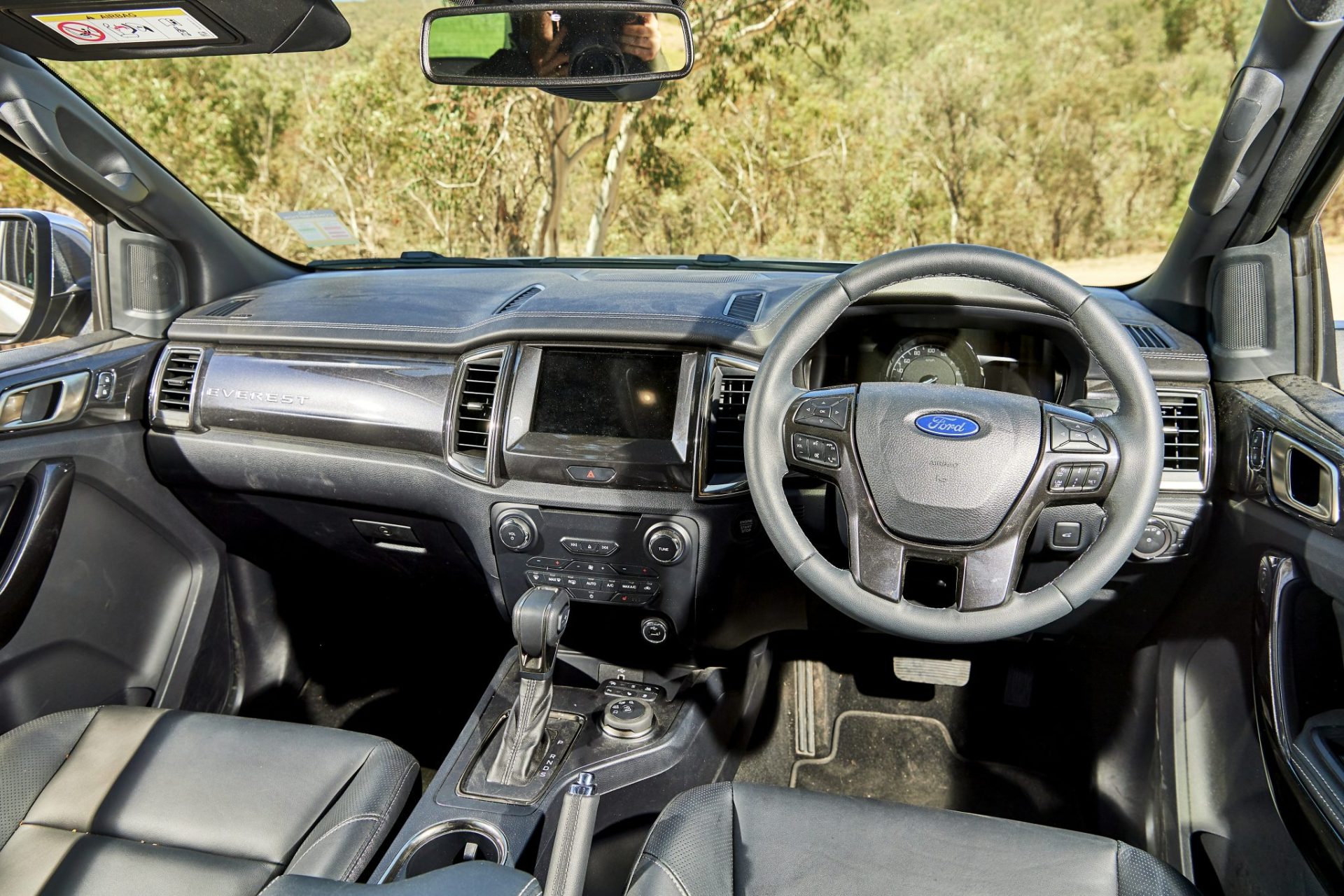
Move to the Everest, and you instantly feel like you’ve got room to stretch out, both in the front and the back. Speaking of the back seats, they can be both reclined and moved forwards and backwards for more room (or to free up space for those in the third row). The driver’s seat is big and broad, and while it doesn’t offer the side support through the backrest the front seats in the Pajero Sport do, the Everest’s front seats offer a longer seat base making it more comfortable for those with long legs.
What are they like in the third row?
For an adult? Not great. The seats themselves are nice and comfortable, and there’s good headroom in both the Pajero Sport ‘s and Everest’s third-row seats, neither offers enough foot or legroom for an adult to sit comfortably.
It’s a hell of a lot easier to raise the third-row seats in the Everest. You simply press a button on the right-hand side of the boot, and they raise out of the floor automatically. The Pajero Sport’s seats, however, have to be raised and lowered manually and they can be a real pain. But getting into the back of the Pajero Sport is a hell of a lot easier than the Everest. But, like a lot of seven-seat vehicles (Everest too) you’ve got to get into the third row via the road-side of the vehicle which is not ideal. The second-row seat tumbles and folds forwards leaving a large-ish opening to climb straight into the back. The Everest isn’t quite as easy, and you’ve got to clamber over the folded seat into the back.
And what about boot space?
The Everest offers the bigger boot of the two (check the specs below for the capacity), and that’s particularly noticeable if you’re using all three rows, just don’t expect to load either of these vehicles with enough luggage for seven if you’re using every seat. The Everest’s tie-down points are sturdier than those on the Pajero Sport, and they fold flat too, which is a nice touch.
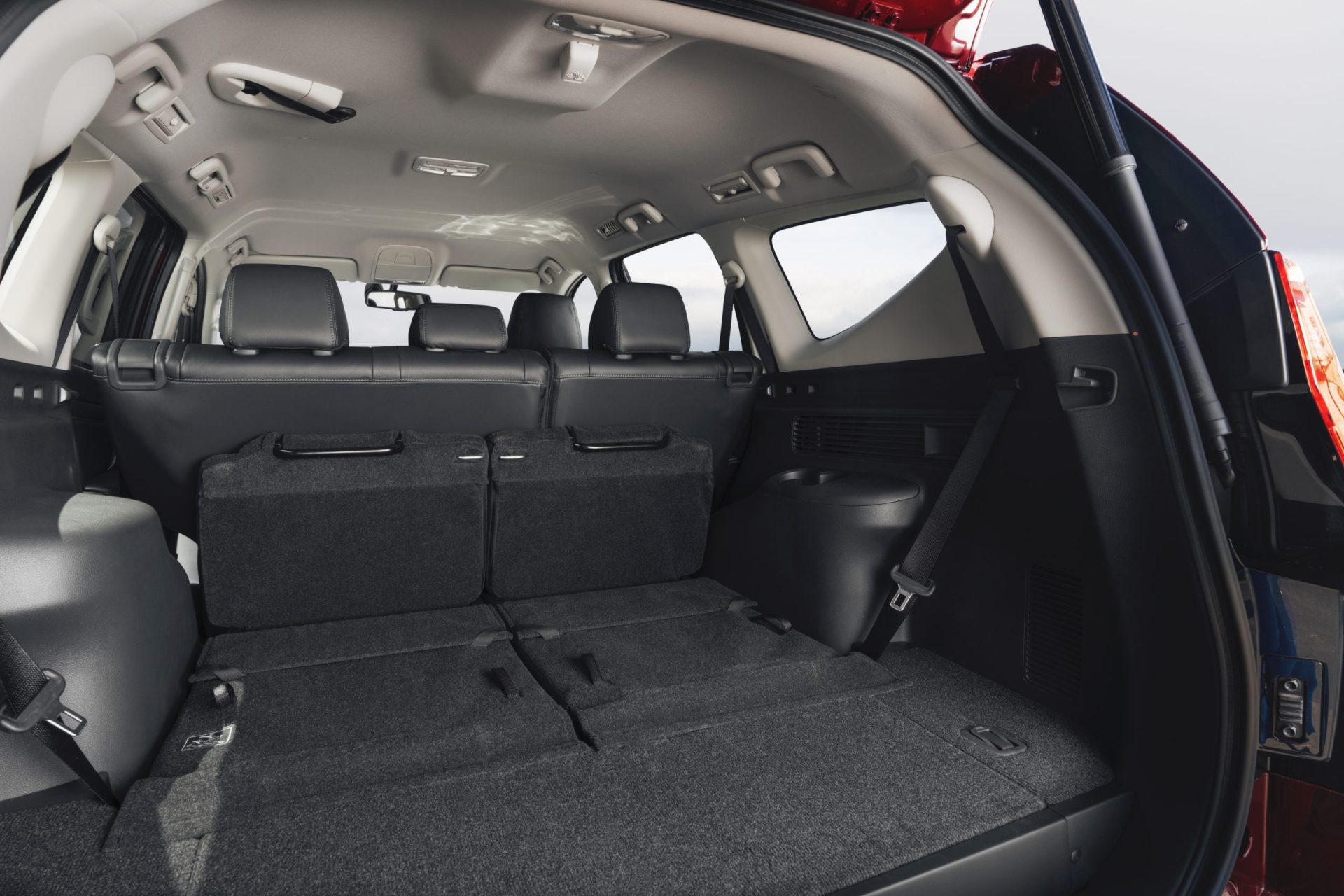
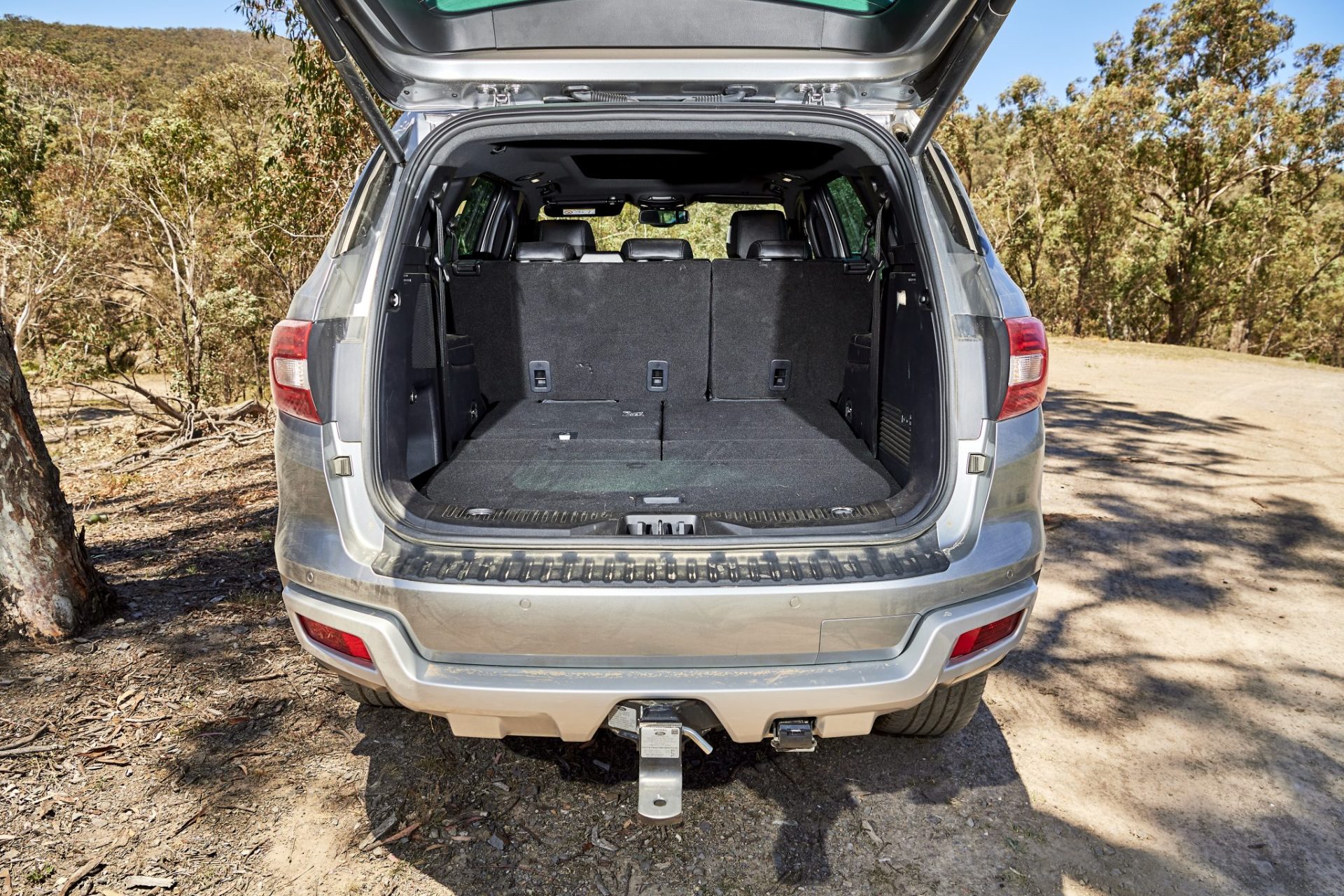
What’s the performance like?
The Pajero Sport carries on with its 2.4-litre four-cylinder turbodiesel making 133kW and 430Nm of torque. This is mated to an eight-speed automatic transmission while fuel consumption is a claimed 8.0L/100km (combined). The Everest Titanium’s 2.0L bi-turbo four-cylinder might be a smaller engine, but it gets an extra turbo and makes 157kW and 500Nm of torque, and this is mated to a 10-speed automatic transmission.
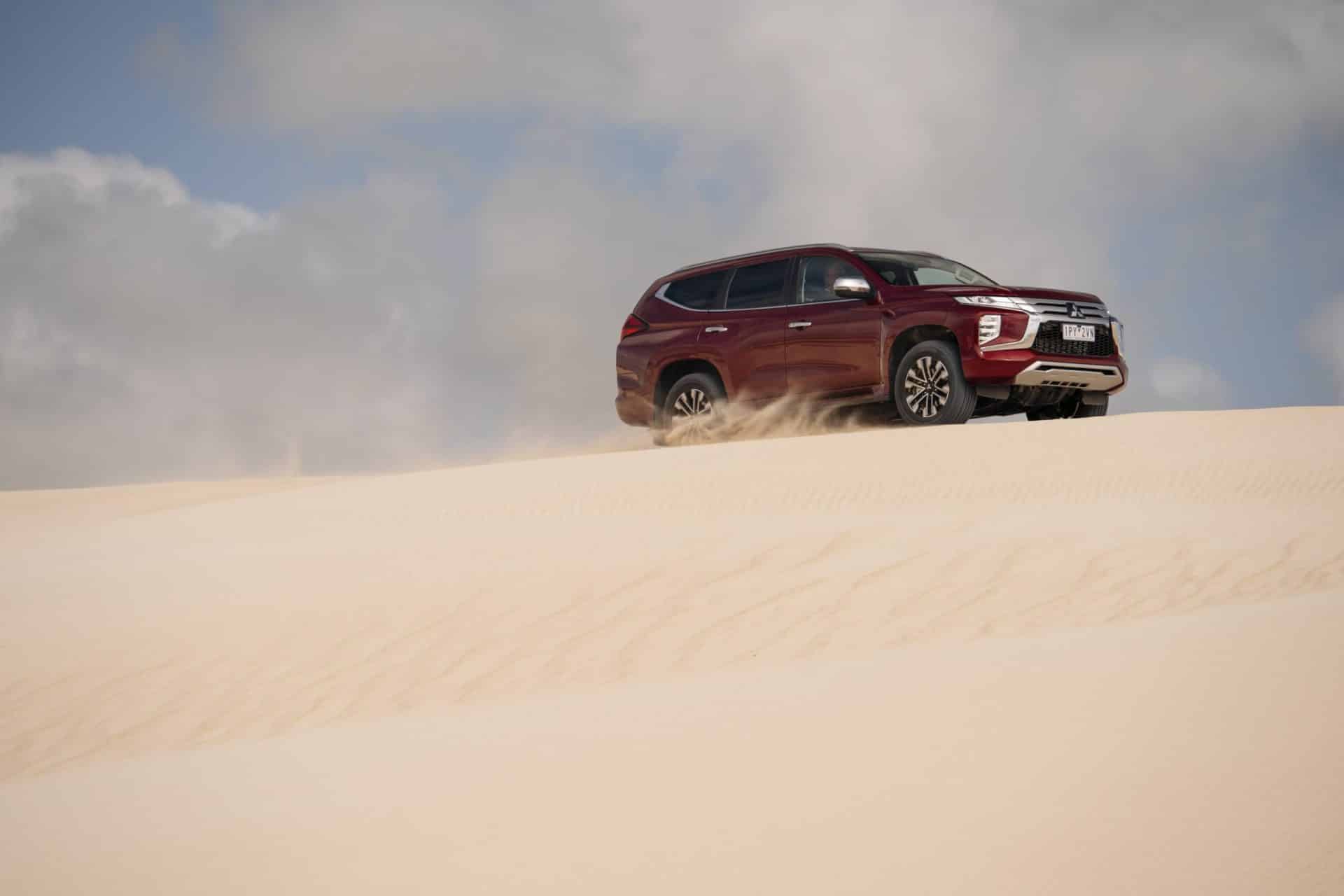
Don’t make the mistake of driving the Pajero Sport after you’ve driven the Everest because you’ll be underwhelmed. In isolation, though, there’s more than enough power and torque for keeping up with traffic although when loaded with people and gear the eight-speed automatic feels more like a six-speeder. On the whole, the transmission is fairly clean in its responses but into and out of corners and up and down hills (any undulating terrain, really) can see it hunt or slur its shifts.
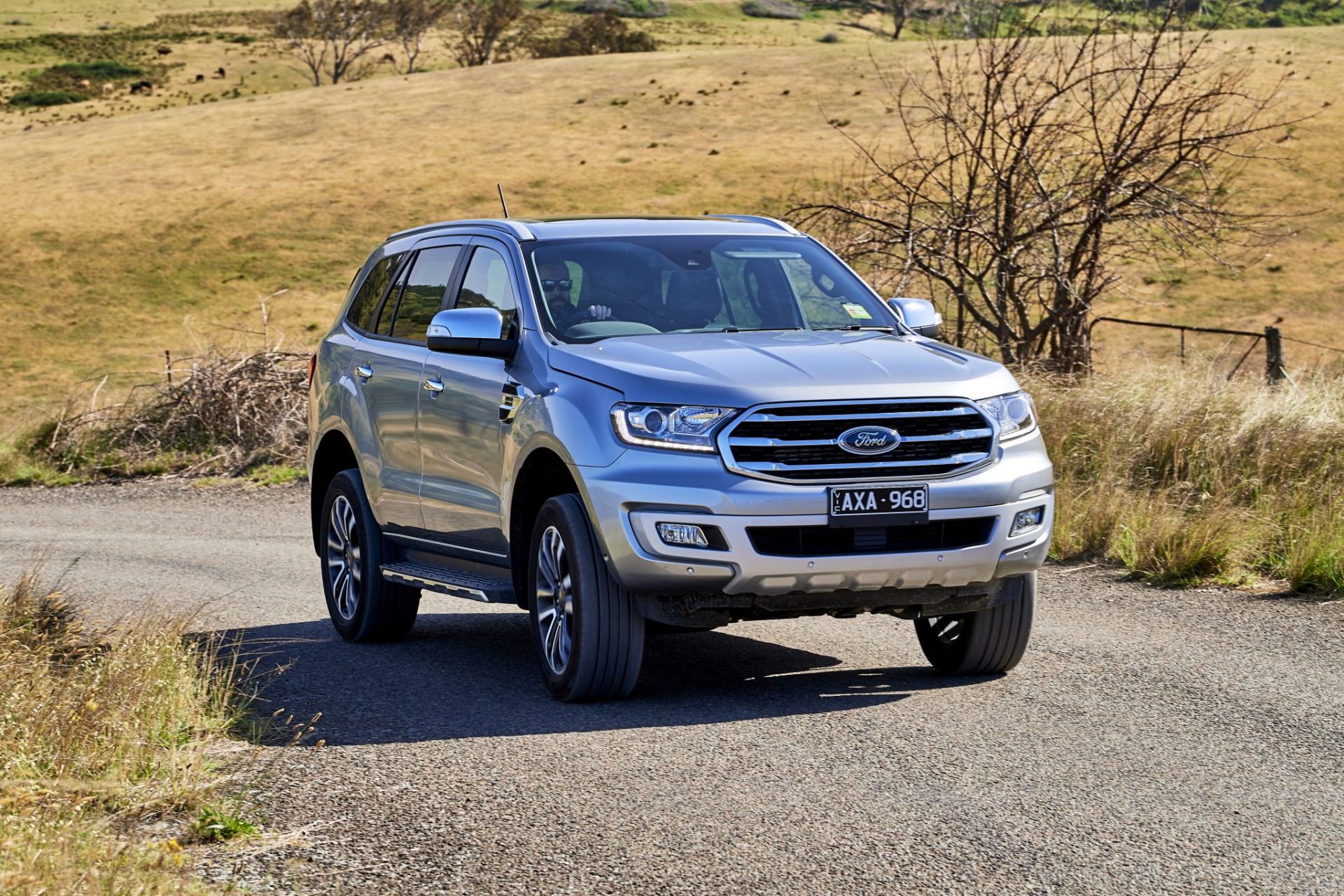
The Everest, on the other hand, feels energetic with a strong in-gear response and the 10-speeder does a much better job of keeping you in the right gear in undulating terrain. And it’ll shift down a gear or two on long downhill sections offering decent engine braking. Interestingly, the Everest’s engine is making more power and torque earlier (500Nm from 1750rpm Vs 430Nm at 2500rpm) than the Pajero Sport, so it feels a lot more relaxed to drive.
What’s the ride and handling like?
The Ford Everest is easily the best of the ute-derived 4X4 wagons and hides its commercial vehicle origins very well indeed. In fact, through corners and across bumps in the road, it feels more like a performance wagon than a big 4X4. Body movement is well controlled, the steering is well-weighted and responsive with no dead spots, and both noise and road-shock insulation are excellent.
Unfortunately, the same can’t be said of the Pajero Sport. Our tester was fitted with a factory-fit bullbar, and clearly, the Pajero Sport’s front end hasn’t been designed from the factory to cope with the extra weight (my impression only). Hit a bump in the road at highway speed, and the front end all but collapses under the weight. Indeed, body movements aren’t as well controlled as the Everest, and the steering is lifeless and slow.
What are they like off-road?
The Pajero Sport feels a whole lot better at off-road driving speeds than it does at highway speeds. It feels better balanced and more controlled too with the slower steering no issue when you’re inching your way across rough terrain.

Our time with the Pajero Sport Exceed saw us drive it across ruts and dirt roads, some mud, water and rock. We didn’t get to drive it across any sand (we’ve used press images). And it’s the same for the Everest Titanium, so it means we’re comparing apples with apples here, as far as performance is concerned. Indeed, they were both driven across the same roads on different days.
The Pajero Sport claims 228mm of ground clearance although I measured closer to 225mm. And it’s the same for the Everest, it too claims and measures 225mm. So off-road ground clearance is good enough for a standard 4X4 wagon. Both vehicles are pretty clean underneath with no bits hanging down or exposed to get caught up on. And the off-road angles are okay too.
Both vehicles get a locking rear differential but on the Pajero Sport engaging it kills the traction control on the front-end, and often you’re better off relying on the electronics and leaving the locker out. On the Everest, you can activate the locker without affecting traction control on the front wheels which is great. So that’s a win for the Everest.
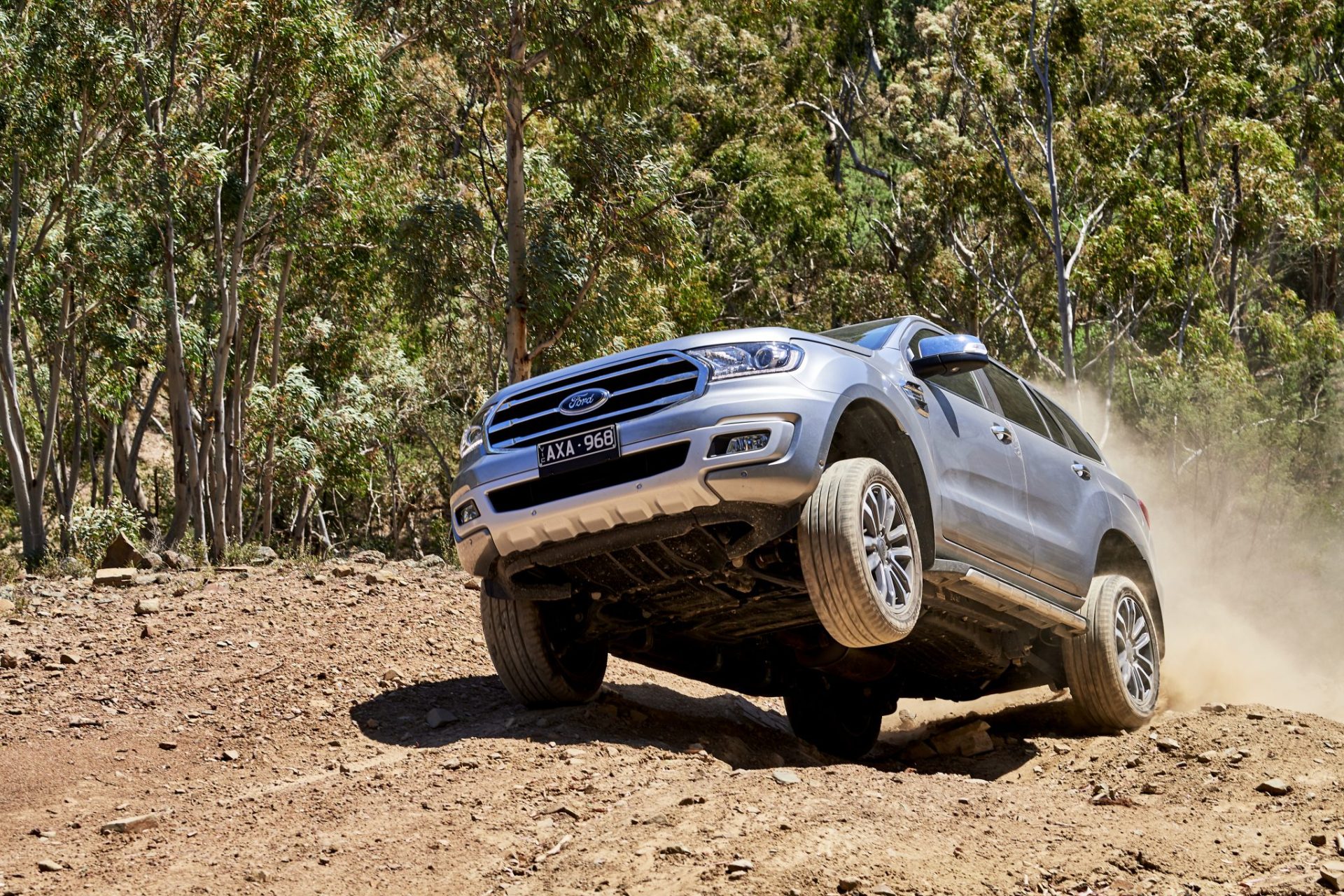
The Everest is permanent four-wheel drive meaning you’ve got good grip on both wet bitumen and dirt without having to touch anything. The Pajero Sport can be driven in both two-wheel drive and four-wheel drive on high traction surfaces; most other 4X4 wagons can only be driven in rear drive on high-traction surfaces like bitumen.
Neither the Pajero Sport or the Everest has a lot of wheel travel and cock a wheel easily in rough terrain.
It’s hard to split the two when it comes to hill descent control, both will get down to a walking pace, but my seat of the pants feeling is that the Everest’s is a touch quicker and quieter. But, interestingly, the Pajero Sport’s hill descent is better than relying on low-range and manually selecting a gear; on one steep section, I tried both methods and just about needed a change of pants using low-range alone. Not so the Ford, which offers better manual gear control. For short downhill sections, the hill descent control on both is the way to go – just remember to give these systems time to cool down if you’re on long downhill sections.
The main Achilles heel for the Everest is its wheel and tyre package. Sure, you can get more aggressive 20s, but it still doesn’t give you a lot of meat in the sidewall for airing down. The Pajero Sport rides on 18s and was fitted with Light Truck Toyo Open Country rubber. They’re not an aggressive tyre, but they’re a solid tyre and an okay starting point. The Pajero Sport is the pick if you’re looking to fit a second battery under the bonnet; it offers plenty of room whereas the Everest’s pretty tight.
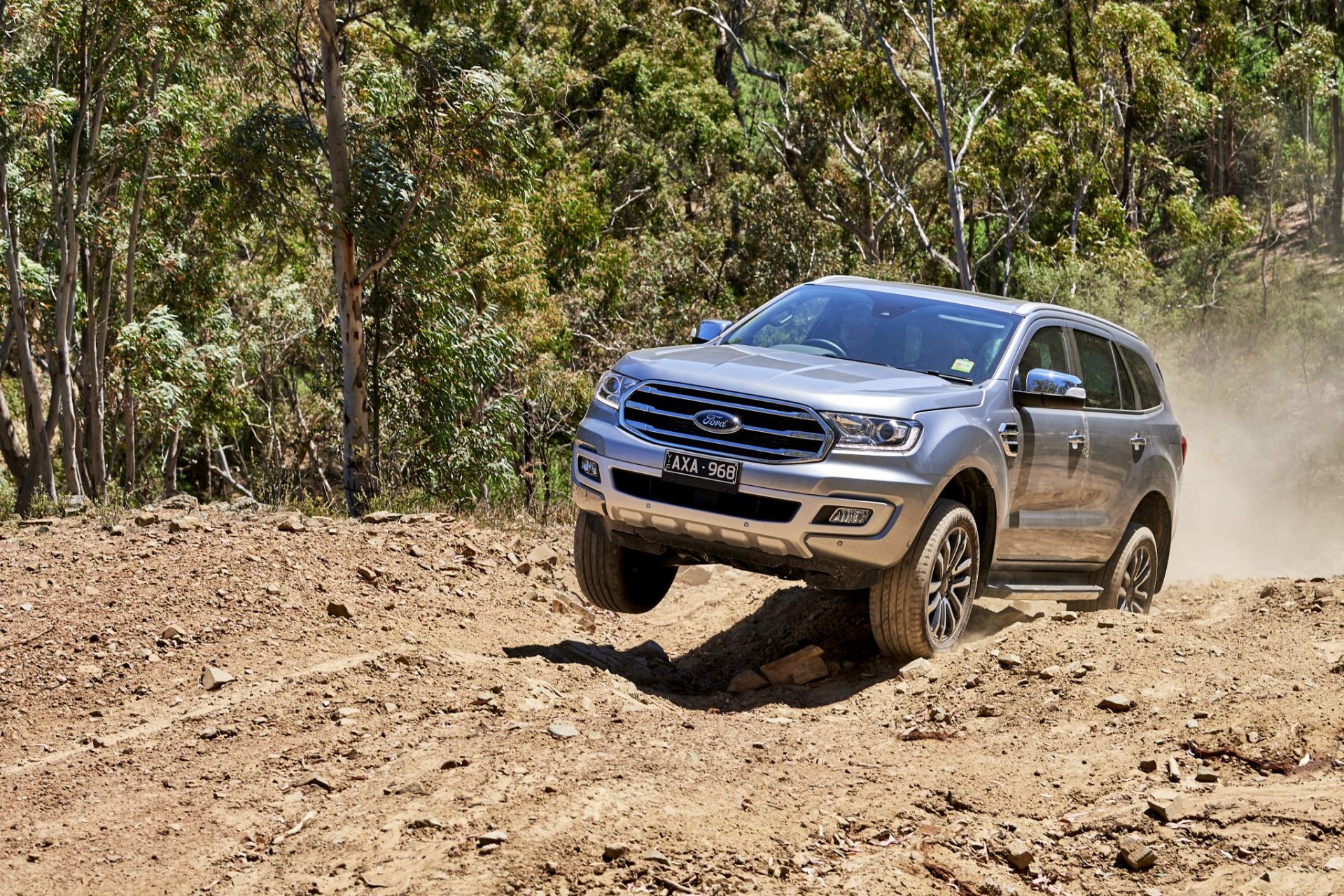
In the end, as good as the Pajero Sport is off-road in standard form, for me, the Everest is the pick. It’s traction control, throttle sensitivity and engine make for a smoother drive in the rough stuff, and even when it does pick up a wheel in rough terrain when you’re using the rear diff lock traction control is still working on the front so you’ll keep driving forward where the Pajero Sport will scrabble and need a lot more work to coax up tough terrain.
What about towing, which one’s best?
Well, unfortunately, we didn’t get to tow with them, but we can crunch some numbers. The Pajero Sport offers a 3100kg braked maximum towing capacity and a GCM of 5400kg. This means if you’re towing a 3100kg trailer you’ve got 2300kg left for the vehicle and payload. The vehicle’s kerb weight is 2105kg which leaves you with 195kg of payload, but this hasn’t taken into account the towball download of around 10%, so you can’t technically tow at the maximum braked towing limit. When you’re not towing you’ve got 605kg of payload via a GVM of 2710kg.
The Everest offers a 3100kg braked towing capacity and a GCM of 5900kg. If you’re towing a 3100kg trailer, you’ve got 2800kg for the vehicle and payload. The Everest’s kerb weight is 2446kg which is full of fuel but no driver, you’re left with 354kg for payload, but this doesn’t take into account the towball download.
So, realistically you’re better off towing closer to the 2000kg mark with both the Pajero Sport and Everest as this will give you your best chance at being able to put anything into the vehicle when you’re towing.
What about ownership?
Ford offers a five-year, unlimited-kilometre warranty. Service schedule is 12 months, or 15,000km with Ford offering capped price servicing running from $360 for the first service to $585 for the second, $470 for the third service, $585 for the fourth service, and so on. Mitsubishi offers a five-year, 100,000km warranty which is off the pace compared with Ford. It too offers capped price servicing for three years with each service costing $299.
So, which one wins and why?
This isn’t cut and dried because of the significant price differential. Drive them back to back both on and off-road and the Everest Titanium is the better vehicle; it’s more comfortable and capable, it’s also better equipped. But, the Pajero Sport Exceed is a lot cheaper. Confused? Yep, me too. Look, if you take money out of the equation, the Everest Titanium is the clear winner here. But if your budget won’t stretch, then the Pajero Sport, as long as you can live with its limitations, like the fact it’s a much smaller vehicle, then it represents exceptional value for money. A cop-out? Yeah, probably.
